


Yes, the photos are unusually small today, but if it’s any consolation, it’s because this post is going to be an unusually long one, even by my hyper-communicative standards. So fasten your seatbelts and extinguish all smoking materials, everybody — it’s going to be a bumpy ride.
Oh, you thought I was going to post fluff pieces for Christmas week? Au contraire, mon frère: I’m hoping to wrap up Formatpalooza by the end of the year, so we have a lot of ground to cover. Besides, you asked for it.
You in the collective sense, of course: ever since I first started Author! Author! readers have been asking in the comments how to format letters, diary entries, newspaper articles, and other text-within-text opportunities within manuscripts. Today, I’m going to be answering that perpetual item on Literary Santa’s gift list.
Who do you thinks gives the good children books?
I begin today’s lesson with a parable. As someone who travels a lot (I teach all over the place, should anyone be interested in flying me someplace to hear me talk about, say, querying or pitching), I’ve become accustomed, if not precisely resigned, to the fact that pretty much every airport in the country has slightly different security regulations. Even within any given airport, enforcement is variable. What is required in, say, Los Angeles will sometimes get you scolded in Duluth — and sometimes even in Los Angeles, if a new manager happens to come on shift between the time you place your items on the conveyor belt and when they emerge on the other side.
Seriously, I’ve seen lipstick confiscated as a potential liquid in Seattle (yes, really), but been chided in Newark for cluttering my requisite 1-quart bag of carried-on liquids with Perky Passion. New Orleans seems to harbor an antipathy against pointy tweezers, a fear apparently reserved in Boston for the smallest gauge of knitting needles. In Chicago, I heard a lady screamed at because it hadn’t occurred to her to place her asthma inhaler in the plastic bag with her carried-on liquids; in Newark, the same poor woman was permitted to retain her inhaler, but was grilled mercilessly about the glass jar of seasoned salt that she was taking to her sister.
If there is any sort of national standard about whether shoes should be placed in a box or directly upon the conveyor belt, it must change at least twice weekly. And don’t even get me started on how a security guard reacted when I was reading Reza Aslan‘s fabulous new compilation of Middle Eastern writing, Tablet and Pen, in the Houston airport last month. Silly me, I thought, “Ma’am, what are you reading?” was an invitation to a literary discussion.
Like all of us, I try to be flexible, open-minded, and cooperative, reminding myself that the person chiding me for doing precisely what the official in the last airport told me to do four hours ago is merely enforcing the rules as she understands them, and that alerting her to the fact that she is apparently the only security officer in the continental U.S. that genuinely believes that socks, hats, and scarves, as well as shoes, need to be removed and run through the scanner is unlikely to improve the situation. Chances are, she’ll only get miffed, and I’ll still end up strolling through the metal detector barefooted except for the Perky Passion gracing my toes.
Coming home from a southern city that shall remain nameless earlier this year, however, I received an instruction that left me dumbfounded. After I scurried, shoeless, through the metal detector, the security officer made a grab at my skirt. “I have to pat it down,” she told me when I snatched it back. “New regulation.”
New, as in it had apparently been made up on the spot; this was a good six months before the new scan-or-pat rules were publicly announced. It also appeared to be rather sporadically enforced: even as she articulated it, beskirted women were passing unmolested through the three other security stations. As were men in baggy pants, priests in vestments, and bagpipers in kilts.
“I flew wearing this skirt two days ago,” I told her politely, “and nobody ran his hands over it. Is the regulation new as of today?”
She looked at me blankly. “I suppose,” she said after a moment’s thought, “I could have you turn around while I did it, to make it less embarrassing.”
A brief, enlightening chat with her very apologetic supervisor later, she still apparently didn’t understand just how she had misinterpreted the latest instructions. “But the skirt’s below her knee,” she kept saying, as if a strumpet in a miniskirt on that particular snowy 27° day would have been substantially less suspect than a lady dressed for the weather. “I have to pat her down, don’t I?”
As I reclaimed my hem from her grasp, I thought of you, my friends. Honestly, I did. There’s a moral here, one’s that’s highly applicable to any aspiring writer’s attempt to navigate all of the many conflicting pieces of formatting advice out there: while the rules themselves may be constant, interpretations do vary. In situations where the deciding party holds all the power, it’s best not to quibble over even the wackiest interpretations.
Or, to put it in the terms we use here at Author! Author!: if the agent of your dreams has just tweeted angrily that she hates seeing a second space after a period with a venom that less stalwart souls reserve for the sound of nails scratching a blackboard, being cut off in traffic, and nuclear war, it’s simply not worth your time or energy to pointing out that those spaces are in fact proper in typed documents in English. You’d be right, of course, but if she’s sure enough of her interpretation to devote 127 words to it, I can tell you now that you’re not going to win the fight.
Trust me, I’m not saying this because I am too lily-livered to take a stand on principle. Ask the security guard I gave a ten-minute lecture on the importance of a diversity of literary voices in a free society.
Give that agent PRECISELY what she says she wants — yes, even if finding out what she wants involves checking her agency’s website, guide listing, and her Twitter account. (I know, I know — that’s pretty time-consuming, but remember, it has probably never occurred to her that the good writers querying her are probably also trying to discover similar information for twenty or thirty other agents. She’s just trying to come up with something interesting to tweet.)
But don’t, whatever you do, assume that particular agent’s pet peeve is shared by everyone else in the industry, any more than one security guard’s antipathy to women carrying — gasp! — lipstick onto airplanes is a universal standard. As we’ve seen earlier in this series, not only are some of the newer standards far from standard; adhering to some of them might actually alienate more traditional agents and editors.
In fact, when trying to decide whether to follow any new guideline you’re hearing for the first time, it’s always prudent to consider the source. Someone new to the rules — who, for instance, is simply passing along a list he discovered somewhere — is far more likely to apply offbeat interpretations than someone who has had a great deal of practical experience with professional manuscripts. Advice heard first-hand from an agent or editor at a conference can (and often does) alter considerably by the time it becomes fourth- or fifth-hand news. All it takes to skew the message is one link in the chain to get a tiny detail wrong in the retelling, after all.
Or, as with my would-be groper, to misunderstand a key word or phrase in the original instructions. One person’s suspiciously abundant fabric below the waistband is another person’s lyrically flowing skirt.
Unfortunately, offbeat interpretations of the rules of standard format are not the exclusive province of fourth-hand advice-givers. Sometimes, newly-minted contest judges and even freshly-trained Millicents can give a tried-and-true rules a mighty original twist. In a contest that gives entrants critique or an agency that permits its screeners to scrawl individual observations in the margins of its form-letter rejections (as some do), even a small misunderstanding on the reader’s end has resulted in perplexing feedback for many an aspiring writer.
Even more unfortunately, the Mehitabels and Millicents producing this feedback seldom think to phrase their understanding of the relevant rule tactfully. To them, the rule’s the rule, just as calf-length skirts were security threats to my airport guard; why not just bark it as though it was true everywhere in the known universe?
The cumulative result of all of that barking of all of those interpretations of all of those rules: writers often end up feeling scolded, if not actually yelled at and shamed. Hands up, if this has ever happened to you.
My hand is raised, by the way. Back in my querying days, a West Coast Millicent once huffily informed me that he’d hated my premise when he’d first read my query three months before at his previous job in an East Coast agency — and he still hated it now. So much so that he took the time to write me a personalized rejection letter: a good two-thirds of a page of snarling admonition about doing my homework before querying. Evidently, I should have been following his professional movements closely enough to have taken wincing pains to avoid running my query under the same screener’s eye twice.
Shame on me for not having read his mind correctly. The next thing you know, I’ll be reading or wearing a skirt in an airport, scofflaw that I am.
Realistically, though, what good would it have done my submission to argue with him? It was indeed absurd of a faceless, anonymous Millicent to expect any aspiring writer to know anything about who is working behind the scenes at any agency, much less who is moving from one agency to another and when.
But do you know what would have been even more absurd and misguided? My automatically assuming that barker was right, simply because he was speaking from an apparent position of authority and with vehemence. Contrary to popular opinion, being right and sounding insistent have no necessary relationship to each other.
I’m bringing this up not because it is integral to understanding today’s foray into the complexities of formatting — it isn’t, especially — but to reiterate the importance of not simply adopting every formatting and writing tip you hear. Look those gift horses very closely in the mouth before you ride any of ‘em home.
Yes, even the ones grazing in my pasture. Many a soi-disant writing guru has ultimately proven to be factually wrong, and when that happens, it’s not the guru that gets hurt; it’s the aspiring writers who blithely follow his advice because it sounds authoritative. Ditto, unfortunately, when aspiring writers misinterpret agents’ pronouncements of their personal preferences as iron-clad rules of the industry.
Remember: when in doubt, the smart thing to do is ask follow-up questions; many an aspiring writer has run afoul of Millicent simply because he didn’t fully understand Rule #10 on an under-explained list of 27. Isn’t that a better use of your energies than fighting with an agent who cares enough about her personal hatred of italics to tweet about it every other month?
Another smart thing to do is to put in the necessary research time to track down a reasonable answer from a credible source. And yes, Virginia, that often means doing more than just Googling the question and averaging the answers on the first ten sites that pop up.
Since there actually isn’t all that much out there on today’s topic, I’m going to state it in nice, easily-searchable terms: today, we’re going to be talking about how to format a letter, diary entry, or long quote in a manuscript.
Or, to be more precise, the many different ways in which one could format them. The short answer to “How do I do that?” is, as it so often is in this game, it depends.
Upon what, you ask? Well, upon the length of the letter one wants to include, for one thing. Also, if we want to get technical about it (and the masses cry, We do! We do!), it depends upon whether the manuscript in question is an academic work or not — or is a nonfiction work of the type often produced by academics.
That last declaration left some of you scratching your heads, didn’t it? And like sensible writers, you formulate a follow-up question: “Why on earth would it make a difference whether a professor — or someone else who aspired to that level of expertise — wrote the darned thing? Standard format is standard format, isn’t it?”
Well, it is and it isn’t. Long-time readers, chant it with me now: what is proper in a book manuscript is not necessarily what’s proper in a short story manuscript; what’s expected in a book proposal is not precisely what’s expected in a novel submission; contests often have specific rules that run contrary to the prevailing rules of standard format. And as we have so often discussed, if an individual agent or editor publicly expresses a personal preference, anyone who submits to him should honor it. It’s the writer’s responsibility to check what’s appropriate for the submission at hand.
In other words, sometimes a skirt is just a skirt. Exceptions do exist.
As much as aspiring writers would love it if all written materials were subject to the same standards, assuming that any writing, anywhere, anytime should be formatted identically, or that any stack of papers called a manuscript will look the same, is simply wishful thinking. True, life would be a whole lot easier for writers everywhere if that particular wish came true, but in case you hadn’t yet noticed, the publishing world isn’t really set up with an eye to making things more convenient for those just breaking into the biz.
So how might a scholar handle this problem? A university press — or college professor reading a thesis, for that matter — would expect any quotation longer than 3 lines of text to be offset, devoid of quotation marks, and single-spaced, provided that the quote in question is not longer than a page; quotes less than three full lines long are simply placed within quotation marks. Offsetting, for the benefit of those intrepid readers who did not automatically skip the rest of this paragraph immediately after the words university press, is achieved by skipping a line, then indenting the quoted material five spaces (or half an inch, using Word’s standard tabs) on both the left and right margins. After the quote comes another blank line, then the text resumes normally.
In practice, then, a page featuring quotations in an academic manuscript might look a little something like this:

Why do scholars mark quotes from other works so VERY well? That way, there can be absolutely no question about when a professor is borrowing material from somebody else’s published or unpublished work. (There tends to be a lot of unpublished work floating around the average university at any given time, after all.)
In a book proposal or nonfiction manuscript that isn’t a memoir, it’s perfectly permissible to present long quotes in this manner — although in non-academic nonfiction, the offset quote would be double-spaced. It’s clear, it’s direct, and most important of all, Millicents who work for NF-representing agents will get it. (Although most ultimately published memoirs begin life as book proposals, at least in the U.S., memoir manuscripts follow the formatting conventions of novels. Hey, I don’t make the rules; I just tell you about ‘em.)
“That’s all very well and good,” enough of you to get together and raise a barn are probably muttering, “but this doesn’t really address Dave’s question, does it? You’ve told us that a letter in a novel or memoir manuscript should not be treated like a quote one academic lifted from another and stuffed wholesale into her dissertation, but you don’t tell us how it should be handled. And how about showing us a practical example of that double-spaced offset quote you mentioned above?”
Don’t worry: a concrete example follows below. (Hey, I wasn’t kidding about the length of this post!) On the other front, patience, my friends, patience — because, again, it depends.
If the letter in question is short (or the excerpt being reproduced in the narrative is), there’s no need to treat it as anything but a regular old quote, like any other in the novel:

Perfectly obvious what’s going on here, isn’t it? It doesn’t require special formatting for the reader to understand that this is an excerpt from a letter.
For short letters — say, under a page — some writers prefer to use italics (probably because, as Dave pointed out, they’ve seen them used that way in published books), but frankly, I wouldn’t recommend it in a novel or a memoir manuscript. It implies an ignorance of the fact that the editor, not the author, is always the one who makes decisions about how text will appear in a published version.
However, since some of you are undoubtedly not going to listen to me on this one, here is how to use italics properly in this context:
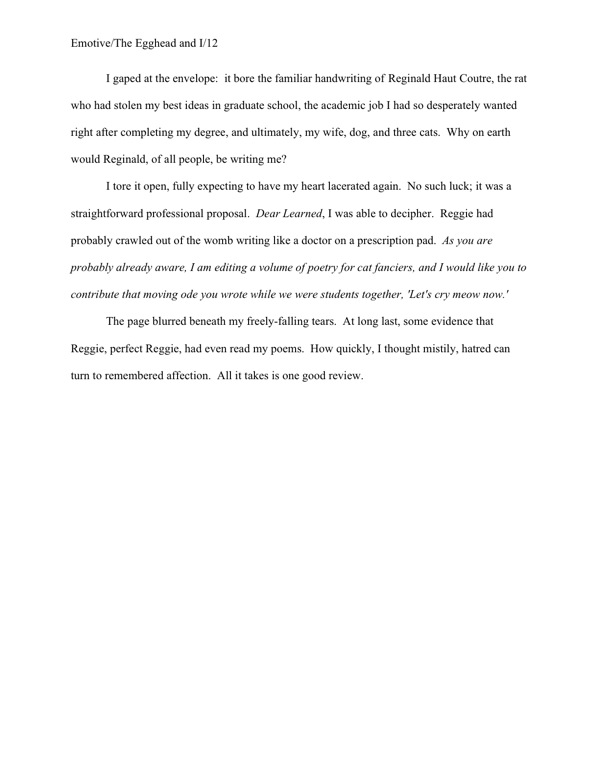
I sense some of you shaking your heads. “But Anne,” epistle-lovers everywhere cry in protest, “that doesn’t LOOK like a letter. I like a letter to look like a letter on the page; that’s part of its charm. So how do I convey that without seeming as though I’m usurping editorial authority?”
I had a feeling I would be hearing from you literalists: there’s no shortage of writers who feel very strongly that every single syllable of every note passed between characters must be reproduced faithfully and its entirety in the text, as if the average reader had never seen a letter before and thus could not even begin to imagine what one might look like.
Frankly, it’s seldom actually necessary to a plot to include the parts of a letter that would be hard to squeeze within the strictures of standard format: the letterhead, if any; the date; the salutation; the signature. Within the context of a novel (or memoir), some or all of these are often self-evident: honestly, if the heroine is addressing her long-lost lover by, say, his given name and signs with her own, what additional insight could even the most imaginative reader derive from reproducing those salutations and signatures for each and every letter they right? Or even just one?
Even if she habitually opened with, “Dear Snotnose,” and signed off with, “Your affectionate bedbug,” that would only be character-revealing the first time she did it, right?
But you head-shakers are not convinced by that, are you? I sense that I’m not going to be able to blandish you into believing that the 15-page letter starting on pg. 82 might work better simply broken off into its own chapter entitled The Letter, am I? (A fabulous solution with very long letters, by the way.)
Rather than fight you, I’m simply going to show you the two acceptable ways of formatting a letter like a letter in a manuscript — which, not entirely coincidentally, will also work beautifully for letters that go on for pages and pages. First, unsurprisingly, it may be presented like dialogue, within quotes:

As with any other multi-paragraph quote, quotation marks do not appear at the end of a paragraph if the opening of the next paragraph is still part of the letter. They do, however, show up at the beginning of each paragraph within the letter, to alert the reader that this is not normal text.
The other option — and this will work with long quotes in nonfiction as well — is to offset the letter text, as one would with a long quote in an academic work. In a non-academic manuscript, however, the offset quote should be double-spaced, like the rest of the text:
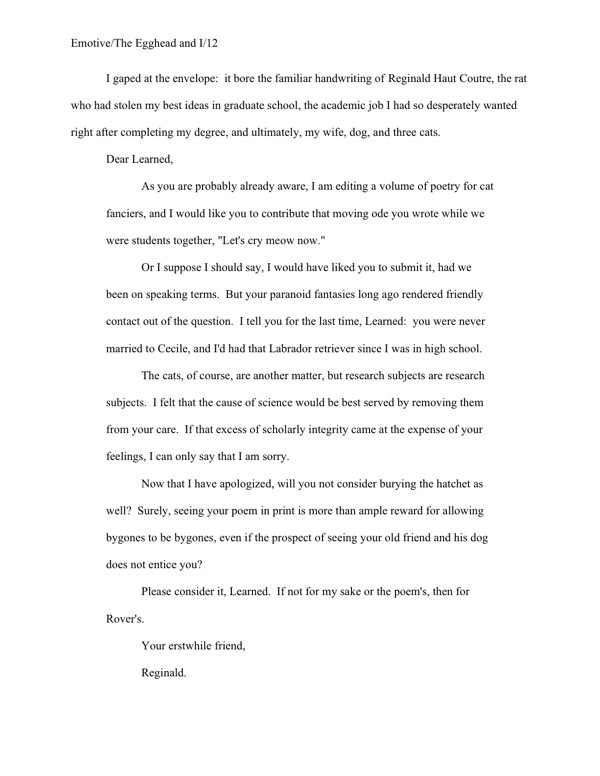
Although this format does work well for long quotes, I’m not a huge fan of it for letters in fiction or memoir. To my eye, it’s not as distinctive as the first option, and there’s always the off chance that a rapidly-skimming reader (like, say, Millicent) might not realize that the salutation is the opening of an offset section.
Don’t laugh; it happens, and not for reasons that necessarily reflect negatively upon the average Millicent’s intelligence. She’s got hundreds of pages to get through in any given day, and skimming eyes can miss details.
Or, to put it a bit more bluntly: don’t fall into the extremely common aspiring writer’s trap of believing that every reader will read — and more importantly, absorb — every single syllable on every page of your entire manuscript.
Sometimes, being obvious is a really, really good idea, especially in a situation where a part of the text is deliberately in a different voice than the rest of the narrative, as is almost always the case with a letter. Bear in mind that because manuscripts do not resemble published books, the goal here is not to reproduce the letter as you would like to see it in the book or as the protagonist saw it — it’s to make it absolutely clear when the text is an excerpt from a letter and when it is not.
Like academic publishers, Millicents don’t like to leave such things open for interpretation; it tends to make her bark-prone. Don’t make her guess where a letter — or any other long quote — begins or ends. The format should make it clear — but never, under any circumstances, use a different typeface to differentiate a letter from the rest of the text.
That last format would work beautifully for an article or diary entry. Again, though, if all the reader needs to know could be summed up in a few short sentences, why not quote the diary entry within the regular text, just as you would an excerpt from a letter?
“But Anne!” diary-lovers exclaim. “I like to see entire diary entries in novels or memoirs! Even if some of the material in the entry is off-topic or even a trifle dull, that just adds to the sense of realism!”
Okay, okay — I know an idée fixe when I hear one; I’m not even going to try to talk you out of that one. (Except to remind you: Millicent’s threshold of boredom is quite a bit lower than the average reader’s. So’s Mehitabel’s; edit accordingly.) Let’s take a gander at all four types of diary entry format on the manuscript page.
Yes, I did indeed say four — because, again, it depends on the type of manuscript in which the diary entry appears. In a scholarly work, it would look like this:
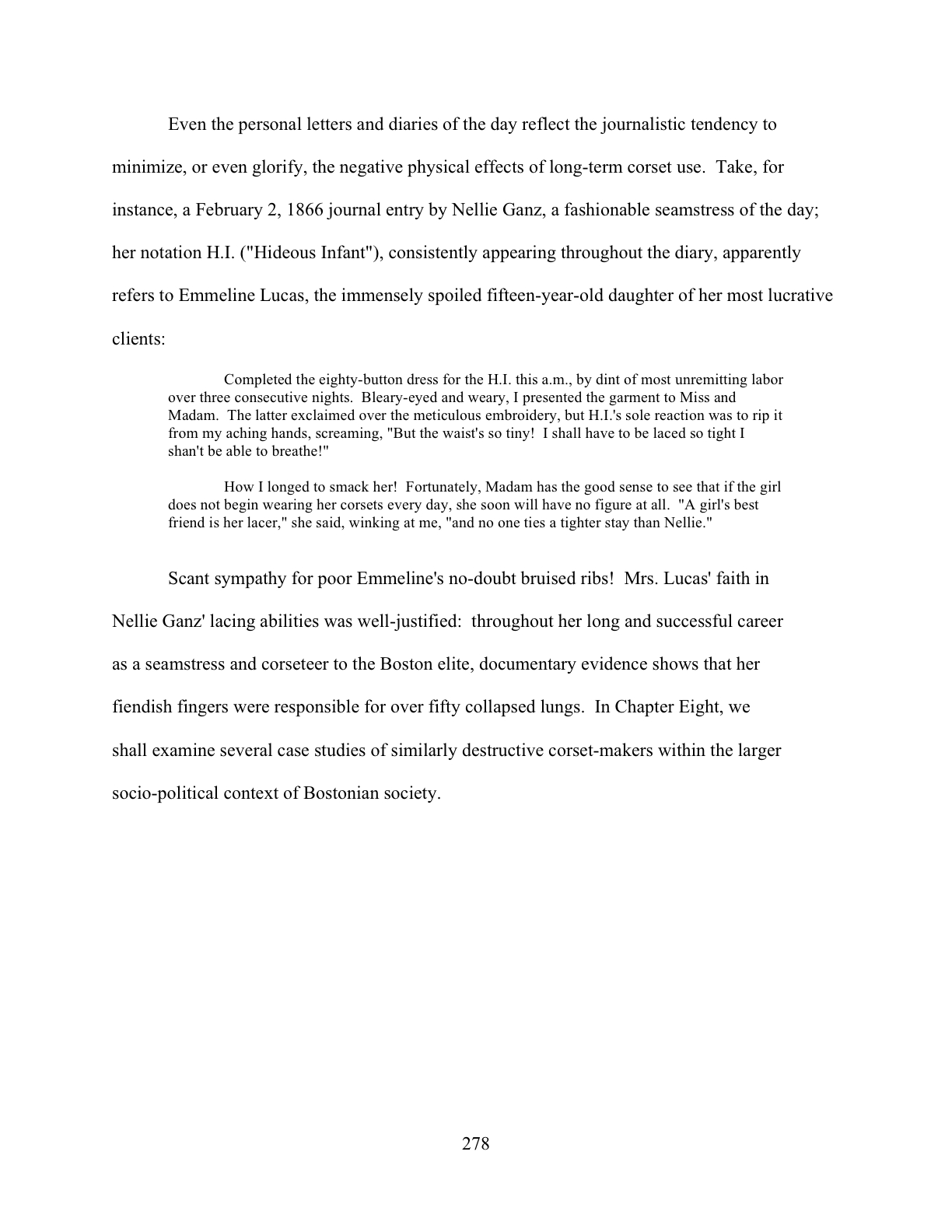
That’s not a tremendous surprise, right? In a nonfiction book on the subject not aimed at the academic market, however, Nellie’s diary would look like this on the page:
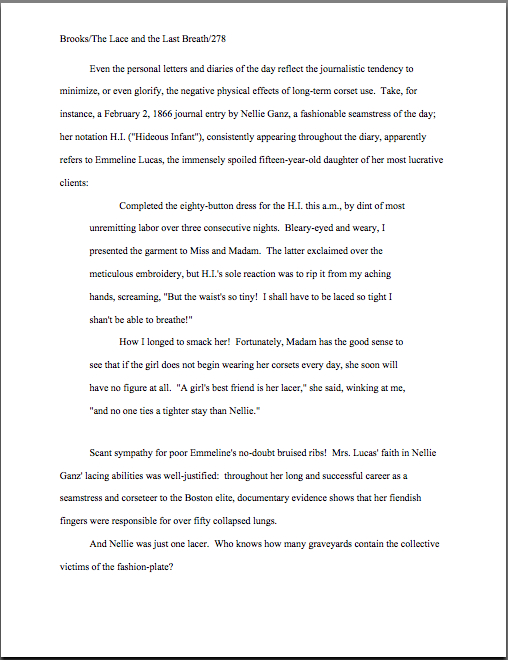
No chance of Millicent’s not spotting the difference between the academic version and the standard format version, is there? To her eye, only the latter is formatted for professional consideration.
If the nonfiction writer preferred not to introduce the date of the entry in the paragraph preceding the diary entry, she could use a NF convention we discussed last week, the subheading. For many writers, there’s a distinct advantage to presenting a diary entry this way: a subheading, the entry would more closely resemble the way a reader might find it in a published book — although, again, that’s not really the goal here.
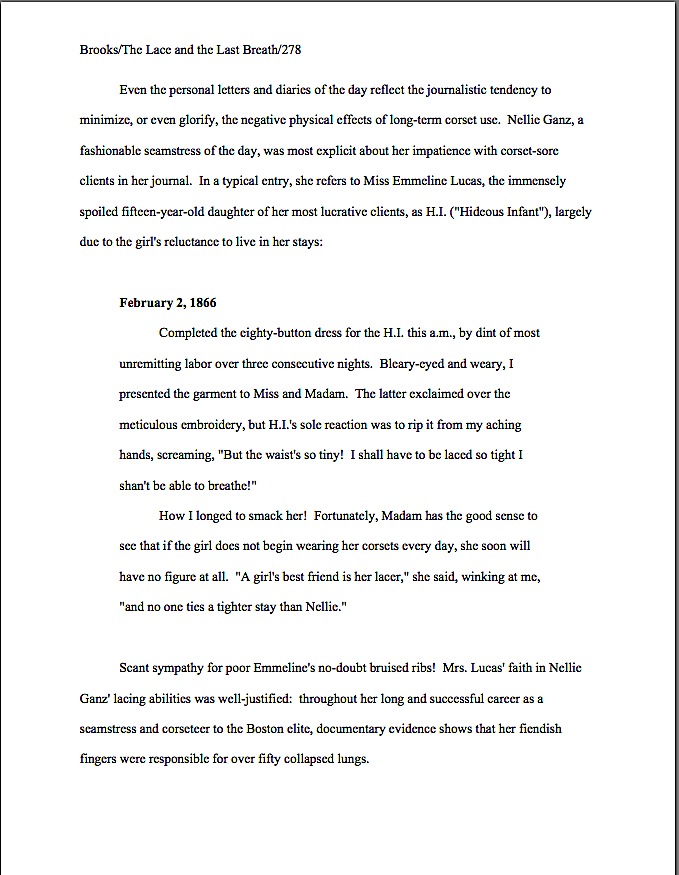
As you may see, this format takes up more room on the page — not always a minor consideration to a writer who is trying to edit for length. As with a letter, the more of the formal elements the writer chooses to include, the more space it will take. Which begs the question: is verisimilitude it worth taking up an extra few lines of text in a manuscript that’s already a bit on the long side? If so, a less literal rendering of frequent letters and diary entries can be a quick, easy way to reclaim a page or two of lines over the course of an entire manuscript.
For fiction or memoir, a similar format should be used for diary entries longer than a few lines but less than a couple of pages long — unless several diary entries appear back-to-back. (But of that, more below.)
A novelist or memoirist faces a structural problem, though: it can be considerably harder in fiction to work the entry’s date into the preceding text (although many a fine writer has managed it with such sterling phrases as The minute volume trembled in Gerald’s hand. On May 24, 1910, his mother had written:), so the subheading is a popular choice for indicating the date.
As with other subheadings in fiction, the date should not be in boldface. Let’s take a peek at what the resultant short diary entry would look like on the page.
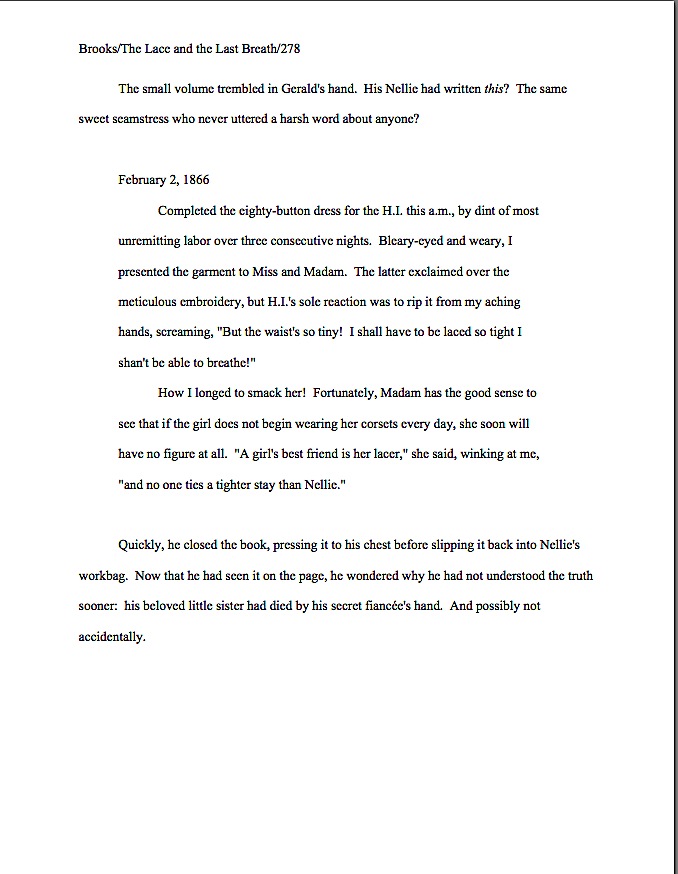
Still quite clear what is and is not diary entry, isn’t it? By offsetting the text, even a swiftly-skimming Millicent would find it easy to figure out where Nellie’s words end and Gerald’s thoughts begin.
But how, you may well be wondering, would a writer present several short diary entries in a row? If the diary did not go on for more than a couple of pages, all that would be necessary would be to insert a section break between each.
In other words, by skipping a line between ‘em. Like so:
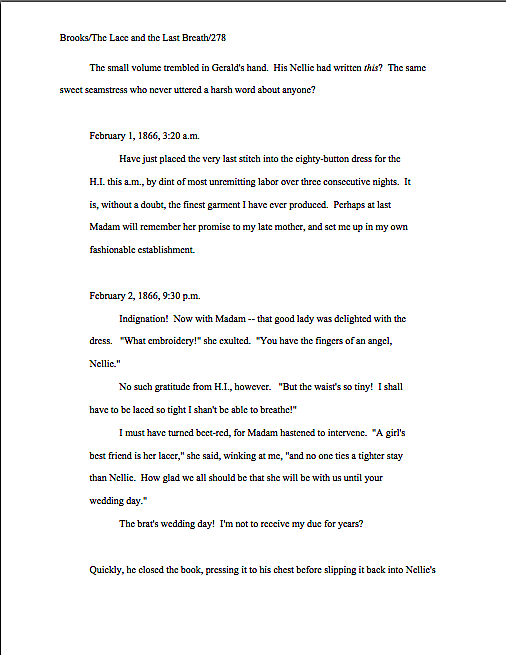
If a series of diary entries goes on for pages at a time, however, offsetting them makes less sense; the point of offsetting is, after all, to make a clear distinction between the special text and the regular text. After the third or fourth page of offsetting in a row, a skimming Millicent (or, more disastrous, an agent flipping forward in the manuscript) might leap to the incorrect conclusion that the margins just aren’t consistent in this manuscript.
May I suggest an elegant alternative, one that would side-step the possibility of this type of misinterpretation entirely? Consider devoting an entire chapter to them, titling that chapter something descriptive and unprovocative like Nellie’s Diary, and formatting all of the entries as regular text with subheadings.
Curious about what that might look like? You’re in luck; here are the first two pages of Chapter Eight:


Lovely and clear, isn’t it? It’s also, in case those of you who are trying to shorten your manuscripts happen to be interested, the most space-efficient means of presenting these diary entries on the page. What a difference a half an inch of margin on either side makes, eh?
If working through this often-misunderstood formatting issue doesn’t get me on Santa’s good list, what possibly would? Tomorrow’s foray into more formatting mysteries, perhaps. Keep up the good work!
Anne, I’m confused…helllllp.
What about articles? I have a couple of newspaper articles in the police procedural, and I’ve broken them up with character business so it’s not a solid chunk of yammering. Also, I cut them way down from what they were at first. Like this:
“PROSTITUTE, CUSTOMER FOUND DEAD,” the headline blared. Below, in smaller type, “Motel Serial Killer Still At Large.”
Why was this all the way in the back? The Black Bandit should have been back here, not this. He read the article.
RALSTON (AP): The bodies of a man and a woman found Tuesday in a local motel room have been confirmed by police as the latest victims of the Motel Shooter, a possible serial killer who is targeting area prostitutes and their customers.
Customers. Huh. Idiots, risking disease or worse. He took a gulp of coffee and the hot liquid burned his throat.
Mmm hmm, here we go. Names–who cares. Aha.
Bullets recovered from the bodies at autopsy matched .9mm rounds found at two other similar crime scenes.
No way they could trace the gun. .9mm weapons were like cigarette butts in the gutters. They were everywhere.
Okay, I did not put spaces before and after the article bits, but they are offset. Assuming Millicent gets this far (this is in Chapter 4), would she disgustedly throw it in the round file thinking I’m an idiot?
I must be a little confused, too, Elizabeth, because I don’t completely understand your question. You already seem aware that article excerpts should be treated precisely like a diary entry or letter: offset, double-spaced.
Are you asking whether I think the back-and-forth alternation between the article and musing works? That’s impossible to tell, out of context, because as an excerpt, there’s no way of knowing whether the various asides are adding to the scene surrounding the article. (At first glance, paragraph #3 does not seem to add much.) Also, I can’t tell whether the article is supposed to be only two sentences long (paragraph 2 + paragraph 4). If so, it seems unnecessary to break it up; why not just show the two-sentence article, then have the character react?
Or are you asking if there is a general rule of thumb for how long an article excerpt should be before it is broken? There isn’t, but I would avoid going on for pages. If the article cited is only a paragraph long, as seems to be the case here, there’s really no reason not to give it in one chunk.
I still sense that I’m not really getting your question, though. What am I missing?
You’re not missing anything; I’m just confused.
So offset and double-spaced, I have that. I guess I was trying to ask about the space before and after the article, if it was the same as a letter. I can put the reactions at the end and put the spaces before and after. I guess that might look better. You’re right; it is kind of short for me to break it up.
Thank you, Anne.
Oh, I see. Yes, it should be the same as a letter.
Hi there! I’ve been a lurker here for the past week, and that has been enough for me to change my first manuscript from it’s former published-book-wannabe shape to a — hopefully — more standards-adhering one. Many millions of thanks, really! I had never (and still haven’t) come across any other source of this kind of information nearly this comprehensive and practical. My sincere and astonished kudos to you.
I’m here also to ask you a question, but rest assured that the paragraph above was as sincere as can be — be it far from me to try to trick such a helpful professional reader!
Anyway, here goes (because I couldn’t find it in the search and so forth): how would I go about formatting the lyrics of a character’s song in my manuscript? From the examples in this post I went for setting both left and right indents to half an inch and inserting a blank line both between the regular text and the lyrics and between the song stanzas (only two in this particular case). I have left the stanzas double-spaced and haven’t italicized them.
Since you have known Millicent for so long, do you think she’d like it?
Oh, in case I haven’t said it already, thank you very much for your effort on this blog! It is priceless in the most flattering meaning of the word. You’ve earned yourself a fan.
I think she would be perfectly fine with that, Peter. Some agents would have you single-space the lines, but as not all would, I would go with the double.
I can’t resist adding, though, that if you did not write the lyrics yourself or they are not in the public domain, including them in a published book could be costly. Usually, the writer, not the publisher, is responsible for obtaining the rights. A while back, memoirist Joel Derfner wrote a guest blog on the subject: you’ll find it here.
And thanks for all of the kind words! I love hearing that writers find the blog helpful.
Good to know that I can leave it formatted as it is now—thanks!
As for who wrote the song, it was me: it’s a sorrowful one sung by a character just after his side’s been defeated in battle. (It consists of only two octaves of heroic decasyllables that took me almost a week to get about right. Phew.)
[Just an aside, albeit off-topic, about something I saw you complaining about somewhere: many blog engines allow you to change its style sheet so that you can have, say, saner paragraph indenting and spacing. I think two rules should be enough for you to stop it driving you nuts. Are you absolutely positive yours doesn’t allow that?]
Thanks again!
My recently-departed webmaster thought so, but since the blogging program has updates about fifteen times per year, it’s entirely possible that what I couldn’t do then I could do now. The way it was explained to me at the time (and I think there’s something to this) is that ordinary spacing would render blogs harder to read for most — the eye skips down a backlit screen faster than down a page, so the gap between paragraphs is helpful. That shouldn’t apply to the indentation, though.
This is a wonderful post. I can’t believe how amazingly complicated this formatting stuff can get once you go beyond a simple glance.
I have one question: I’m uncertain of how to reference signs, such as on the side of a building or on the freeway, etc. I’ve been doing it like this:
“…he saw a sign that read: PATROLLED BY POLICE — NO TRESPASSING — FELONY PROSECUTION.”
The ” — ” is to indicate a line break so that it’s not so confusing to read.
Obviously I could just write the information out in non-caps and in quotes, but the all-caps seems more suited to indicating the formality and severity of such a sign. Is that something that would be an editor’s choice and not the domain of the writer’s manuscript?
Thanks again for all your hard work!
Oh, and I do mean the double small dash that you have emphasized many times, and not the long one that appears above!
Thanks!
Thanks, Chris — and I quite agree about formatting being deceptively simple! I’ve been arguing for years that every writers’ conference in North America should offer a crash course on what manuscripts look like. Expecting aspiring writers to pick up on complex principles through short lists of restrictions — or, more commonly, through some mysterious process of osmosis — has always struck me as unrealistic.
On to your question (and I appreciate the clarification on the dashes): yes, how signage is portrayed in a published book would ultimately be up to the editor, but you will be delighted to hear that what you are doing is perfectly acceptable on the manuscript page. It would be more common, though, to render it like this:
…he saw a sign that read: PATROLLED BY POLICE. NO TRESSPASSING. FELONY PROSECUTION.
Or even like this:
…he saw a sign: PATROLLED BY POLICE. NO TRESSPASSING. FELONY PROSECUTION.
You are quite right that your way conveys the impression of more authoritarian urgency, however, so as an editor, I prefer your version. While we are speaking of editorial responses, I should add that because tight third-person narrative submissions so often go out of their respective ways to remind the reader continually that the character through whose perspective the entire tale is told is seeing this or hearing that, professional readers sometimes come to dislike being told that a protagonist saw or heard something in a tight third-person narrative.
Strange, admittedly, but true. So it’s good strategy to consider whether the fact that someone observed something is important enough to a scene to run the risk of prompting Millicent to mutter “Stop reminding me that I’m seeing through the protagonist’s eyes!” in the midst of her already hard day. Often, it works equally well just to show the object in question:
An immense sign appeared at the side of the road: PATROLLED BY POLICE — NO TRESPASSING — FELONY PROSECUTION.
Or, if the impact of the sign upon the observer is important, you could emphasize that:
He switched off his flashlight so the guard would not spot him. Ten feet later, he bumped his nose upon a sign reading PATROLLED BY POLICE — NO TRESPASSING — FELONY PROSECUTION.
There’s no knowing whether this would work on the page without seeing the rest of the scene, of course. I just thought you would like to know about this particular pet peeve.
Thank you so much! It is a relief to hear that there is some range of expression with caps (or italics) allowed to the writer that won’t seem like amateurish effrontery to an agent or editor.
I’m still generally freaked though about the boundaries of this range. For instance, if I wanted to quote a letter that I described as having erratic capitalization in it (or even all caps), is it permissible in a manuscript to show this? Such as, “the letter read: ‘HeLlO ThEre…’” or “the letter read: ‘HELLO THERE…’” Or should I simply describe it in the prose, quote the letter as normal text, and then bring it up with a (hopeful!) future editor? Or maybe an agent would want to see it anyway, and be turned off by it. (If you wish to answer this, you can just say yes or no! I’m sensitive to taking up too much of your valuable time!)
I’m fascinated by the concept of a manuscript looking very different from a published book since it serves a very different purpose, and is only one step in a whole assembly of production roles. It makes perfect sense, and yet I think most of us newbies never catch onto this. So, thanks for teaching that!
And thanks also for the reminder about too much filtering of the fictional world through the protagonist’s eyes. It does get very annoying.
You’re welcome, Chris — and sorry about the slow reply. Got a bit overwhelmed by deadlines.
My answer on the erratic capitalization front is that if it’s in all caps, I would not put it in the manuscript that way; it’s too hard to read on the page. Save it for discussion with your future acquiring editor.
If it’s erratic, however, my guess is that it would be important to characterization, no? If that’s the case, I would include the odd caps — but make doubly sure that everything within ten pages of the letter was presented perfectly down to the last comma. That way, even the grumpiest Millicent would have a hard time responding to it as a series of typos.